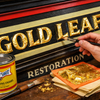Thorn Tip for Gold Leaf: Definition, Purpose, and Usage
- by Sam Wozniak
Gold leaf application, also known as gilding, is a centuries-old technique used to decorate surfaces with an ultra-thin layer of gold. It is commonly seen in artwork, sculptures, manuscripts, picture frames, furniture, and architectural details. Achieving a flawless gilded surface requires precision, skill, and specialized tools, one of which is the Thorn Tip. This tool, though lesser-known than traditional gilding brushes or knives, plays a crucial role in handling delicate gold leaf.
This article will explore the thorn tip for gold leaf, its purpose, how it is used in gilding, and why it remains an essential tool for artisans.
What Is a Thorn Tip for Gold Leaf?
A thorn tip is a small, needle-like tool traditionally made from a natural thorn (such as a cactus spine or rose thorn) or a fine, pointed metal needle. It is used in gilding to manipulate, lift, and position delicate gold leaf without damaging or tearing it.
Gold leaf is incredibly fragile—so thin that even a slight breath or static charge can cause it to fold, wrinkle, or fly away. Because of its delicacy, handling gold leaf requires special tools like gilding brushes (mops), gilders’ tips, and thorn tips.
A thorn tip is particularly useful when:
- Adjusting the edges of gold leaf.
- Lifting and placing small pieces of leaf.
- Repairing minor imperfections.
- Removing excess gold leaf from intricate areas.
In essence, the thorn tip functions as a fine, precise tool that allows the gilder to make subtle adjustments without disturbing the overall gilded surface.
Why Use a Thorn Tip Instead of Other Gilding Tools?
While gilders often use soft brushes (such as a gilder’s mop or tip) and specialized knives, the thorn tip provides unique advantages:
-
Extreme Precision
A thorn tip allows the artisan to make precise movements, especially when dealing with detailed designs, lettering, or small gilded surfaces. Brushes may be too soft and broad to manipulate tiny gold leaf pieces effectively. -
Delicate Handling
Unlike metal tweezers, which can create creases, or fingers, which carry oils that can affect adhesion, a thorn tip gently lifts and places gold leaf without disrupting its structure. -
Ideal for Intricate Work
When applying gold leaf to fine details—such as small carvings, decorative moldings, or calligraphy—the thorn tip can nudge edges into place or remove excess without disturbing the surrounding area. -
Better Control Than a Knife or Tweezers
Traditional gilding knives or tweezers are excellent for cutting and handling gold leaf but are not always ideal for precise positioning. A thorn tip provides more control for fine-tuning work.
How to Use a Thorn Tip for Gold Leaf Application
1. Preparing the Gold Leaf
Before using a thorn tip, the gilder must prepare the gold leaf by:
- Carefully transferring it from its booklet to a cushion or a prepared surface.
- Cutting it to size if necessary using a gilding knife.
Since gold leaf is extremely delicate, it is best to work in a draft-free environment to avoid accidental displacement.
2. Positioning the Gold Leaf
- If using loose gold leaf, a traditional gilder’s tip (a soft squirrel-hair brush) is used to lift and place the sheet onto the prepared adhesive surface (such as oil size or water size).
- If the gold leaf crinkles or does not align properly, a thorn tip can help make micro-adjustments to straighten or position the edges.
3. Fine-Tuning with the Thorn Tip
Once the gold leaf is on the surface, a thorn tip is used to:
- Adjust edges: Sometimes, gold leaf may not fully cover an area. A thorn tip can gently nudge it into place.
- Remove excess: After pressing down the gold leaf with a brush or cotton ball, excess gold clings to edges. A thorn tip can remove this delicately.
- Repair small gaps: If a small section is missing gold, a thorn tip can help place a small piece precisely in the gap.
- Work on fine details: For lettering, fine carvings, or calligraphy, a thorn tip helps refine sharp edges and intricate lines.
4. Final Burnishing and Sealing
Once the gold leaf is fully in place:
- A soft brush or cotton ball is used to lightly burnish (press and smooth) the gold for better adhesion.
- Any remaining excess is gently brushed away.
- If needed, a protective sealant is applied to prevent tarnishing and enhance durability.
Tips for Using a Thorn Tip Effectively
- Use a light touch: Gold leaf is thinner than paper and can easily tear. Move the thorn tip gently.
- Keep the tip clean: Any residue on the thorn tip can cause gold leaf to stick unintentionally.
- Work in a draft-free environment: Gold leaf is so light that air currents from a fan, window, or even breathing too close can displace it.
- Practice on scrap materials: If you're new to using a thorn tip, practice on small pieces before applying it to your final project.
Alternative Tools to a Thorn Tip
While a thorn tip is highly effective, there are other tools that can perform similar functions:
- Fine-pointed paintbrush: Some artists use a tiny, stiff brush for adjustments.
- Needle or pin: A sewing needle can be a substitute but may be less effective than a thorn due to its smooth, hard surface.
- Tweezers: Although useful, tweezers can damage gold leaf if not used carefully.
- Soft erasers or clay picks: These can also be used for micro-adjustments.
That said, many professional gilders prefer the natural flexibility and grip of an actual thorn, making it an invaluable tool in the process.
Conclusion
The thorn tip is a small but powerful tool in the world of gilding, providing unmatched precision for handling fragile gold leaf. Whether adjusting edges, repairing gaps, or working with intricate details, it offers control without damaging the delicate material. Though lesser known than brushes or gilding knives, the thorn tip remains a favourite among professional gilders who require fine adjustments in their work.
Mastering the use of a thorn tip takes practice, but once learned, it becomes an essential part of achieving flawless gilding results. Whether working on furniture, manuscripts, or artwork, this tiny tool plays a significant role in the art of gilding, proving that even the smallest details can make a big difference.






